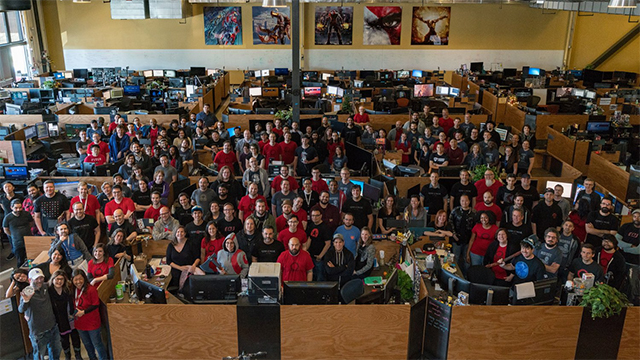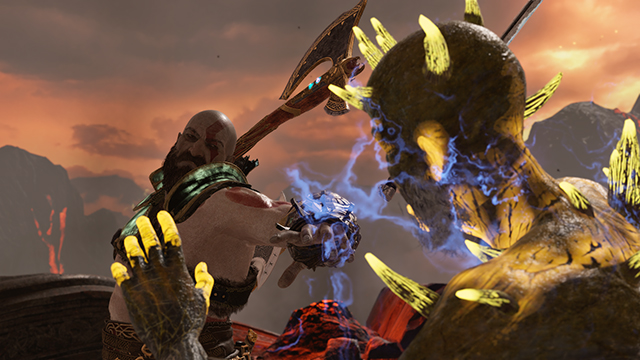God of War cleaned house during 2018’s award season. While its visuals and gameplay were appropriately praised, its narrative and character development seemed to be the factor that pushed it over the edge for many people. The new ax-wielding, bearded Kratos carried an emotional tone and range not seen in the other rage-fueled installments and players took notice. But this journey wasn’t as easy as tempering Kratos’ bellowing and was instead a long, multi-step process that shaped the weathered warrior into a more down-to-earth human.
One of the biggest initial issues was Kratos’ original design. When the idea for the new God of War game was bubbling, Bruno Velasquez, animation director at Sony Santa Monica, started putting Kratos’ PS3 character model with the young Deimos one from Ghost of Sparta as a sub in for the unnamed Atreus. And, as he described in his talk for GDC 2019, it immediately looked odd because Kratos is not built like a normal human.
A Greek freak

He’s got long, gangly arms and feet, enormous hands, and a tiny head, which worked for what those old games required of him. The Blades of Chaos were weapons that had a wide area of effect and is where those freakishly stretched appendages helped out as they gave him even more reach. These “comic book, over the top” proportions worked for the gameplay and the far away camera angles but not when those aspects are no longer the focus.
So when Velasquez placed Kratos in the rough scenes that were going to be in the upcoming God of War game, it was just off. The godly proportions made it difficult to believe in his more human side. This is possibly why the other tender moments in God of War Ascension, Chains of Olympus, and Ghost of Sparta came off as stilted because it just wasn’t believable coming from this pale, pissed off Slenderman. Something had to change so the team made his body more in line with human standards (as shown in the picture above), which immediately helped ground the character in a way that the Spartan basketball prospect never could.
This ideology didn’t just apply to the actual game either as the marketing key art also had a lot to do with it. Many of the magazine layouts and key art for the old games was meant to portray Kratos as an almighty badass. Basically, if it could be a heavy metal album cover, then it worked perfectly. But the 2018 game toned that down, as evidenced by the relatively tame poses found on the box art and other Sony-produced screenshots. Every part of the game had to convey that this was a more mature experience and that included promotional material.
While the team wanted to turn the dial down, Kratos still had to exhibit strength but in a more palatable way. Kills still had to be brutal, but not overly so. The walking animation isn’t a dainty tiptoe or a dramatic sprint, but a “dynamic, strong, and grounded” jaunt that still displays Kratos’ power without overexaggerating it. Velasquez admits that it is still over the top — which, given his power, makes sense — but it is “a little bit more grounded than it used to be before.”
Growing up with God of War and Kratos

Studio culture also had a huge impact on changing Kratos. Velasquez showed a picture of some Sony Santa Monica team members in 2007, which he affectionately calls the “college years,” hanging out and looking relatively carefree. But then he flashed to a more recent photo where he had a wife and two young daughters. And while Cory Barlog, the game’s director, has been open about how his wife and son shaped the game, it wasn’t as clear that this maturation had affected more of the studio. Having a more mature team is what created Atreus as they had more parental life experiences to pull from and this was important given that he was arguably the biggest catalyst for Kratos’ maturation.
Animation also had to change to ground Kratos and is what inspired the team to look more into motion capture. According to Velasquez, 90 percent of the old games were animated by hand and the remaining 10 percent were motion captured in cinematics. And these animations were often dramatic, given the nature of the iconic Blades of Chaos. Motion capture automatically pushed the game in a more realistic territory since a human was doing almost all of the work.
Sometimes these humans were the animators themselves as they were coming to grips with how this tech worked. Velasquez as his cohorts would strap in the mocap suits to sketch out scenes and possible combat moves, which he said was fun but also served a purpose in guiding Kratos to where the studio wanted him to be. After all, if a human could do it, it was believable. It also saved time for things that couldn’t be mocapped like the non-humanoid dragons and the World Serpent.
Finding the right “Boy” (and Kratos)

The actual humanoid, well, humans were also incredibly important in Kratos’ great big makeover as players had to like the characters in order to care about their emotional journeys that were central to the game. Sunny Suljic and Christopher Judge had incredible chemistry as Velasquez said he knew they had their duo once they saw the sample video they made together.
But aside from actual acting chemistry, Suljic and Judge also inadvertently paired well in one other aspect: height. Suljic is just under 5 feet tall while Judge towers over him at 6 foot and 3 inches. It’s noticeable and not unlike the height difference between Kratos and Atreus. And since the team was originally just looking for authenticity, this was a happy accident. It also made the adjustment processes a lot easier since the team didn’t have to account for scale differences in the game. This allowed the performances to be authentic and less about touching it up later.
Combat, however, was a much more arduous task given how the team was ditching the iconic Blades of Chaos in order to give Kratos a new lease on life. The Leviathan Axe started out as a normal axe without many complicated moves or magical properties. But the team found this to be a little blander and ended up “inject[ing] back a little bit of the old God of War games into it.”
Axing a bit of realism

This is where throwing the axe came into play as well as some of the boomerang-like normal attacks. Not only did it make combat more flashy but it did so without sacrificing the realism the designers were striving for. It was a happy middle ground. The symbolism of the Leviathan Axe itself also showed Kratos’ growth since it was a sentimental gift from his wife to protect their child rather than destructive dual swords fused to his arms. And even though these dual swords make a return, they had to be reined in and Kratos didn’t jump around as much with them. In essence, the team grounded Kratos by literally grounding him.
“Grounded” doesn’t mean it still didn’t have heft and somewhat fancy moves. Velasquez talked about finding stuntman and action director Eric Jacobus on YouTube. Jacobus’ skills are quite impressive and he often posts videos about him replicating real-life versions of attack strings in fighting games. This, paired with Jacobus’ enthusiasm, made him an easy pick for God of War to help perform the mocap needed for Kratos’ attacks.
Despite Jacobus’ ability to do things most humans can’t do, Kratos is still a god, meaning that the talented stuntman was able to provide convincing, practical motions while also being just flashy enough for a combat-heavy action game. Like the Leviathan Axe itself, he was able to find the line between video game hyperbole and reality that matched the studio’s vision.
Jacobus helped bring Kratos’ combat into something more real but he was only a small part of what Sony Santa Monica had to do in order to make the God of War star a more feasible character. Finding the right actors, toning down his grandiose animations, using motion capture, changing the character model, and maturing as a team were all cogs that helped change this monstrous maniac into something more worthy of sympathy and care. This might have seemed impossible a few years ago but, given the accolades, sales, and high review scores, it appears to have paid off.
[Image Credit: PlayStation Blog]







